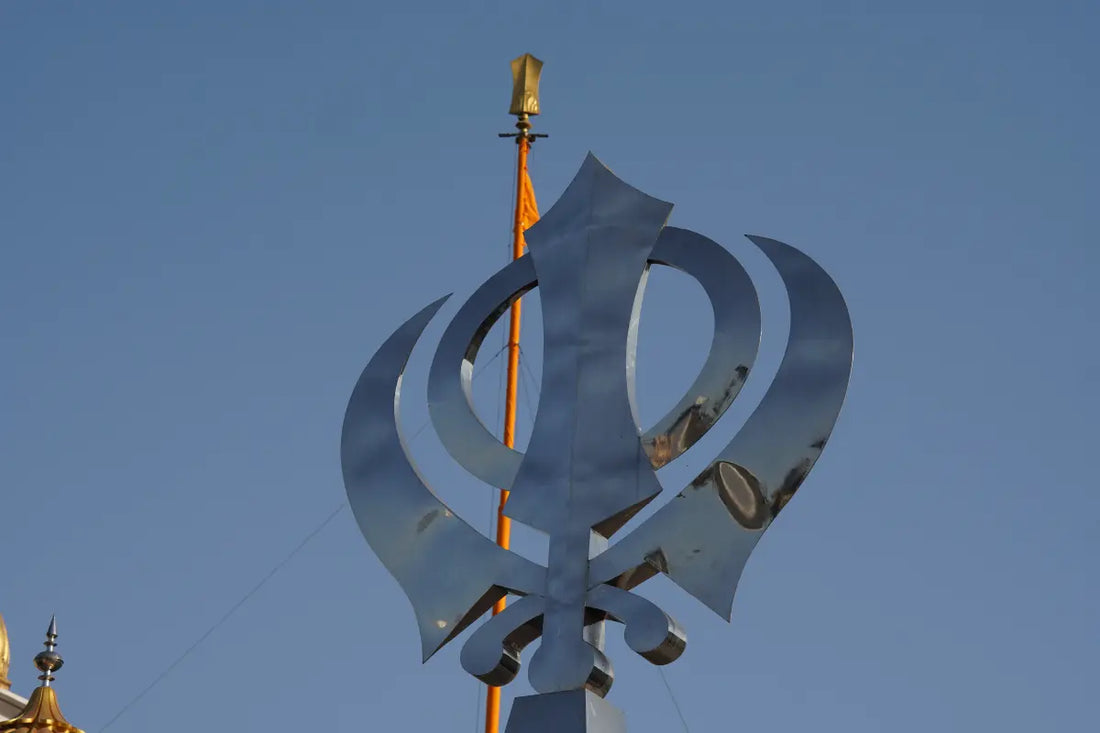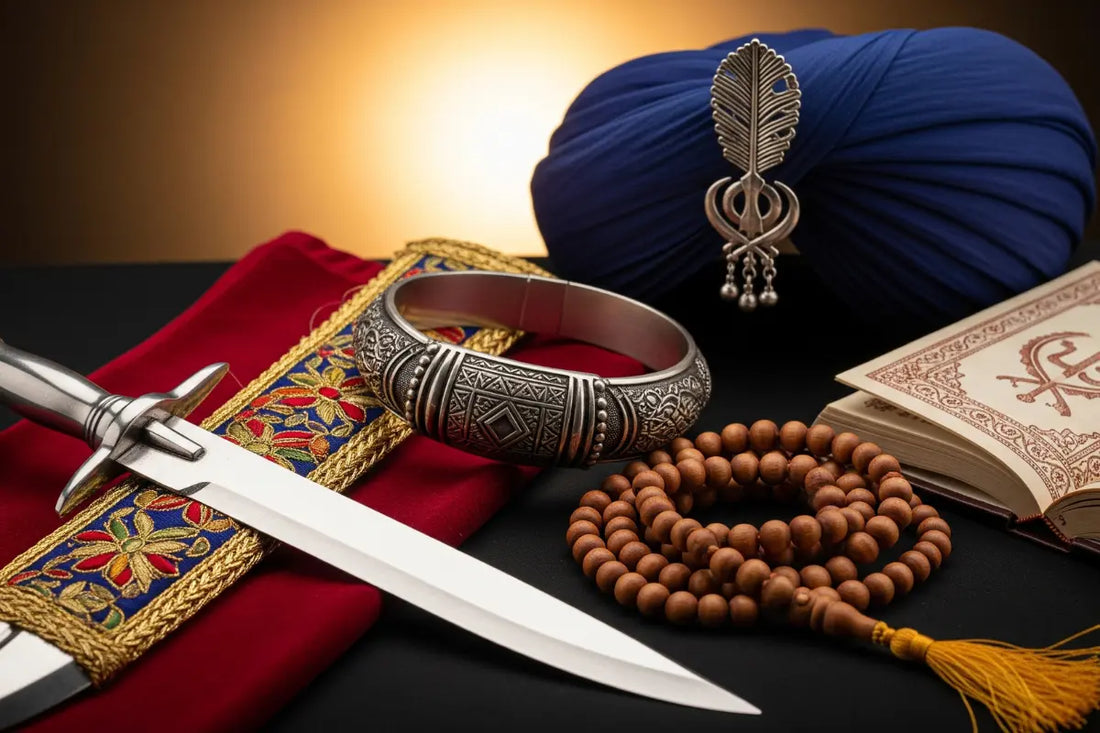News
The Role of Mala (Prayer Beads) in Sikh Daily Practice
In Sikhism, every accessory holds deep spiritual meaning and reflects a life rooted in discipline, devotion, and remembrance of the Divine. Among these sacred items, the Mala, or prayer beads, stands as a timeless sacred aid for meditation and self-reflection. At Akaal Accessories, we recognise the profound spiritual significance of Sikh accessories. From the Sarbloh Mala to the Kara and Khanda, each piece serves as a reminder of inner strength, humility, and faith. This blog explores how the Mala supports Sikh daily practise and how the Sarbloh Mala carries a unique spiritual symbolism that continues to inspire Sikhs across the world.
Learn moreThe Khanda: Meaning, History and Modern Relevance
The Khanda is one of the most powerful and widely recognised Sikh symbols, representing faith, courage, and unity. More than just an emblem, the Khanda carries centuries of history and spiritual depth, making it central to Sikh identity. Today, Sikhs around the world, including in the UK, wear the Khanda symbol on pendants, flags, turbans, and even home décor as a proud expression of devotion.
Learn moreHow Sikh Accessories Reflect Inner Strength and Devotion
Sikhism is a faith rooted in discipline, humility, and courage. Every article of faith carries deep meaning, guiding Sikhs to live a life of truth and service. Among these, Sikh accessories are not just ornaments but sacred symbols of identity, resilience, and unwavering devotion.
Learn moreUnderstanding the Five Ks (Panj Kakaar)
Sikhism, a faith rooted in equality, service and devotion, holds rich spiritual and cultural traditions. Among its most sacred practices is the wearing of the Five Ks, also known as Panj Kakaar — the five Sikh articles of faith that represent a deep commitment to the values and identity of Sikhism.
Learn moreThe Spiritual Importance of Sikh Accessories
Sikh accessories are not merely adornments—they are sacred expressions of identity, faith, and devotion. These symbols, each rooted in divine instruction, carry deep spiritual significance that transcends time and trends.
Learn moreWhat is the significance of Kara?
The Sikh Kara is far more than a bracelet—it is a powerful symbol of faith, discipline, and unity in Sikhism. Among the Sikh Five Ks (Panj Kakaar) that Guru Gobind Singh Ji established in 1699 for the Khalsa, the Kara Sikh holds a special place as a constant spiritual reminder and a daily connection to Sikh identity.
Learn moreWhy Sarbloh Still Matters: The Spiritual Science Behind Iron
To many, a Sarbloh Kara or Kirpan might just look like a traditional piece of ironwork — but for Sikhs, it's something far deeper. Sarbloh (pure iron) holds a special place in Sikh history, spirituality, and martial tradition. From the battlefields of Guru Gobind Singh Ji’s time to the kitchens of the Nihang Singh Dals, Sarbloh has never lost its relevance. In this blog, we explore what Sarbloh really is, why the Gurus chose it, and why it's still important in a modern world filled with stainless steel, plastic, and convenience. 1. What Is Sarbloh? Sarbloh means "all" iron"—pure, unalloyed, untreated iron. Unlike stainless steel or modern metals, Sarbloh is raw and naturally reactive. In Sikh tradition, it’s used to forge: Karas Kirpans and Shastars Cooking utensils (especially for Langar or Amrit Sanchar) Bartan used by Nihang Singhs and Gursikhs during spiritual preparation Guru Gobind Singh Ji instructed the Khalsa to wear Sarbloh as part of their spiritual and martial discipline — it wasn’t just symbolic; it was deliberate. 2. Spiritual Significance of Sarbloh Sarbloh is more than a material — it’s a statement. Here's why it matters spiritually: Humility: It’s unpolished, imperfect, and raw — reminding us that Sikhi is not about decoration, but depth. Discipline: Wearing Sarbloh (especially as a Kara or Kirpan) requires care, rust prevention, and respect. Connection to the Guru: Sarbloh represents the fearless, spiritual warrior spirit given to us by Guru Gobind Singh Ji. Khalsa Identity: Sarbloh is deeply connected to Rehit Maryada (the Sikh code of conduct), especially among Nihang Singhs and Amritdhari Gursikhs. It’s not worn for show — it’s worn to stay grounded, alert, and in remembrance. 3. The Subtle Energy of Iron Even beyond spiritual symbolism, Sarbloh has powerful energetic properties that are only now being studied by science. Iron is grounding — it helps stabilise energy and remove restlessness. Magnetic resonance — natural iron fields interact with our own electromagnetic energy. Water in Sarbloh utensils is believed to become “spiritually charged” — which is why it’s used to prepare Amrit during Amrit Sanchar. Cooking in Sarbloh (e.g. iron kadai) can boost natural iron intake and imbue food with warmth and vitality. While not all these effects are fully explained by science, they’ve been practiced in spiritual traditions for centuries. 4. Why It’s Still Relevant Today In a world of convenience and commercialism, Sarbloh reminds us to slow down, stay rooted, and protect our spiritual integrity. Here’s why it still matters: It connects us to our martial and spiritual lineage It resists the superficial and polished world we live in It encourages maintenance, care, and mindfulness It aligns with a more natural, intentional lifestyle From Nihang Singhs to everyday Gursikhs, Sarbloh remains a part of daily discipline — both physically and spiritually. 5. Sarbloh at Akaal Accessories We take great pride in offering Sarbloh items that honour tradition and spiritual discipline: Solid Sarbloh Karas — raw and rooted in Khalsa identity Sarbloh Shastars — forged with care, reflecting the warrior spirit of Sikhi Sarbloh Dumalla Accessories — including salais and ornaments designed for traditional Dastaar wear Bata (iron bowl) — used in spiritual practice and ceremonial contexts Sarbloh Spoons — ideal for Amrit Sanchar, Langar preparation, or Nihang Maryada Each piece is crafted with intention, authenticity, and deep reverence for the legacy of Sarbloh. Final Thoughts: Iron for the Soul Sarbloh isn’t about metal — it’s about remembrance. It’s a quiet, weighty presence on your wrist or at your side. It reminds you of your purpose, your lineage, and your Guru. And in a world that values shine over substance, Sarbloh stands firm — raw, fearless, and forever rooted in truth.
Learn moreSacred Sound: The Power of Gurbani in Everyday Life
In a noisy world full of distractions, stress, and overthinking, the sound of Gurbani offers something rare — stillness. Whether you’re listening to Japji Sahib at dawn, playing Rehras Sahib on your evening commute, or softly whispering Waheguru while walking — Gurbani isn’t just a prayer. It’s a vibration that realigns the mind, body, and soul. This blog explores how the sacred sound of Gurbani can be part of your everyday life, how it affects us deeply, and how you can build a personal practice that brings daily calm, clarity, and connection. 1. What Makes Gurbani So Powerful? Gurbani isn’t ordinary poetry or scripture. It’s Shabad Guru — the divine word that carries Naam (spiritual essence). Every syllable has rhythm, energy, and intention. When recited or listened to with love, it’s not just heard — it’s absorbed. Gurbani is designed to: Calm the mind and remove mental noise Guide thoughts towards truth and compassion Uplift the soul by connecting it to Waheguru Carry healing vibrations that impact even on a cellular level That’s why even hearing Gurbani — without fully understanding it — still touches something within. 2. Bringing Gurbani Into Daily Life You don’t need hours of free time or a perfect setup. Just a few intentional moments can change the energy of your day. Here are a few simple ways to invite Gurbani into your daily rhythm: 🎧 While commuting: Listen to Japji Sahib, Asa Di Vaar, or soothing Kirtan 🕯️ During chores: Let Rehras Sahib play while you tidy up or cook 🌿 On walks: Whisper Waheguru or pause to reflect on one line from Nitnem 🌙 Before bed: End the day with Kirtan Sohila or soft Simran 🛋️ During stillness: Just sit, breathe, and let one Shabad play gently Over time, Gurbani becomes the backdrop to your day — not just a task on a list. 3. The Science of Sound and Healing Modern science is catching up with what the Gurus already taught — sound has power. Studies show that chanting, vibration, and sacred frequencies can: Reduce anxiety and stress Improve focus and emotional balance Activate the parasympathetic nervous system (rest, repair, restore) Influence water, plants — and yes, our own cells Gurbani is the ultimate spiritual sound therapy — no tech, no trend, just timeless truth. 4. How to Build a Gurbani Routine That Sticks Start small, stay consistent. Here’s how to create a practice that works: 📖 Keep your Gutka Sahib close – bedside, desk, or prayer corner 📱 Use a simple playlist or app – so you don’t have to search daily 💡 Set reminders – for 5-minute Gurbani breaks during the day 🙏 Create a sacred space – even if it’s just a cushion and Rumala Sahib 👨👩👧 Get the family involved – listen together while driving or during dinner prep You’ll be surprised how quickly Gurbani becomes something you crave, not just remember. 5. Support Tools for Your Gurbani Journey At Akaal Accessories, we offer sacred tools to support your daily connection with the Shabad: Gutke Sahib in both English and Punjabi, perfect for daily Nitnem or Simran Mala beads attached to Kara – a subtle yet powerful way to stay present in Waheguru's name Chaur Sahib – crafted for respectful daily use, whether at home or during Paath Each item is made with love and intention — to bring Gurbani closer, in every moment of your day. Final Thoughts: Let the Shabad Guide You Gurbani isn’t just something you read or listen to — it’s something that reads you back. It reveals the truth in your heart, quiets the storms in your mind, and fills your day with spiritual fragrance. So wherever you are, whatever you’re facing, press play… and let the Shabad do its work.
Learn moreSikh Baby Naming Ceremony (Naam Karan): What It Means and How to Prepare
The arrival of a new life is one of the most beautiful moments in any family. In Sikhism, this moment is honoured with a deeply spiritual ceremony known as Naam Karan — the official naming of a newborn, conducted in the presence of the Guru Granth Sahib Ji. More than just a cultural tradition, Naam Karan is a sacred opportunity to start a child's life with the blessings and guidance of the Guru. In this post, we’ll walk you through what Naam Karan is, how the ceremony works, and how families can prepare meaningfully — from spiritual intention to thoughtful gifts. 1. What Is Naam Karan? Naam Karan means “naming through the Name.” It is the formal Sikh baby naming ceremony, usually held at the Gurdwara within the first few weeks of the baby's birth. Unlike secular naming rituals, Naam Karan is about much more than choosing a name — it's about aligning the child’s identity with the divine wisdom of the Guru. During this ceremony, the Guru Granth Sahib Ji is opened at random, and the first letter of the hukamnama (verse revealed on that day) becomes the first letter of the child’s name. 2. The Naam Karan Ceremony Step-by-Step Here's how a traditional Naam Karan unfolds: Family gathers at the Gurdwara, or in some cases, at home with Guru Granth Sahib Ji present Kirtan is performed, creating a peaceful and joyful atmosphere Ardas (prayer) is offered for the child's well-being, health, and connection to Sikhi The Granthi opens the Guru Granth Sahib Ji, and a hukamnama is read aloud The first letter of the first word of the hukam is used to choose the baby’s name The baby is formally introduced to the Sangat with their new name Karah Parshad is distributed to all attending A Langar or small family meal often follows 3. Choosing a Name: What It Represents Sikh names often end in: Kaur for girls — meaning “princess” Singh for boys — meaning “lion” These names signify equality, dignity, and strength. The chosen first name — based on the hukamnama — usually reflects divine virtues like peace, light, truth, or service. For example: A name beginning with "S" could be Simranpreet Kaur or Satdeep Singh It’s not just a name — it’s a spiritual guide for life. 4. How to Prepare for Naam Karan Whether it’s your first child or your third, preparing for Naam Karan is a special opportunity to slow down, connect to Sikhi, and create lasting memories. Here’s how you can prepare: Bring fresh, clean Rumalay Sahib for Guru Granth Sahib Ji Dress your child in soft, respectful, clean clothing Bring Karah Parshad ingredients or arrange Langar Seva Keep a small notebook to write down the Hukamnama and meaning Involve older siblings to help build connection and pride 5. Gifts That Grow With the Child The most meaningful gifts are those that last beyond the moment — items that carry blessings, memories, and spiritual depth. When gifting for a Naam Karan, think beyond baby clothes and toys. Choose something that connects the child to Sikhi, something they’ll treasure years from now. Consider: A baby-sized Kara – A symbol of strength they’ll grow into A personalized plaque with their name and hukamnama – A timeless keepsake A soft Rumala set to honour their connection to Gurbani A mini Gutka Sahib – Wrapped carefully and respectfully A memory box – For their name card, Ardas slip, or first Dastaar These gifts are more than items — they’re silent prayers the child will carry for life. Final Thoughts: A Name With a Blessing Naam Karan is more than a celebration — it’s a prayer. A chance to welcome a child into the world not just with joy, but with Gurmat guidance. It reminds us that identity is sacred, and names carry power when rooted in the divine word. So whether you’re a parent, grandparent, or friend attending a Naam Karan, take a moment to reflect: This isn’t just a new name — it’s a soul beginning its journey with Waheguru.
Learn more








